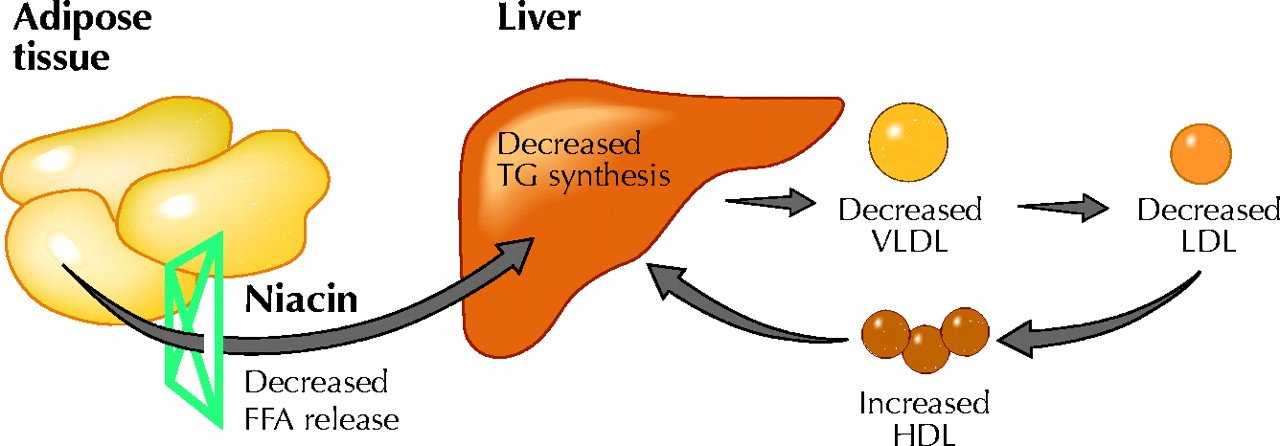
Vitamin B3, also known as niacin, is found in a variety of foods. This nutrient is essential for the skin, heart, brain, gut, and more. As a supplement, it can improve blood lipids and skin complexion, while the effects on heart health are mixed. Read on to learn the benefits, food sources, dosage, and side effects of niacin.
What is Niacin?
Vitamin B3 exists in two different forms: nicotinamide and nicotinic acid – sometimes collectively termed “niacin”. This vitamin is essential for the nervous system, digestion, skin health, and more [1].
A variety of whole and processed, fortified foods contain significant amounts of niacin. Deficiency is rare in the western world and usually limited to chronic health conditions. On the other hand, people from poor regions may lack this vitamin due to general malnutrition [2].
Health Benefits of Niacin
Likely Effective:
1) Blood Lipids
Niacin can improve blood lipids in multiple ways. A solid body of clinical evidence confirmed its potential to:
- Decrease LDL cholesterol [3, 4, 5, 6, 7]
- Increases HDL cholesterol [3, 4, 5, 6, 7]
- Decreases triglyceride levels and total cholesterol [5, 6, 7]
Based on these results, the FDA approved prescription niacin products for irregular blood lipids (dyslipidemia). These products typically come in doses of 500 mg or higher. On the other hand, dietary supplements contain 250 mg or less and thus may not have significant effects [8].
Niacin can improve blood lipids in patients with metabolic syndrome and also HIV/AIDS-related dyslipidemia [9, 10, 11].
Despite its potential to improve blood lipids, niacin doesn’t seem to prevent heart disease or reduce mortality (more details to follow) [12, 13].
2) Niacin Deficiency/Pellagra
Symptoms of a mild niacin deficiency include [14]:
- Indigestion
- Fatigue
- Canker sores
- Nausea
Severe niacin deficiency causes pellagra, which manifests with dermatitis, diarrhea, and dementia (known as the “three Ds”) [15].
Niacin (500-1000 mg daily) can resolve the symptoms within one week; it’s FDA-approved for the prevention and treatment of pellagra. Nicotinamide may be preferred over nicotinic acid because it doesn’t dilate the blood vessels and cause face flushing [16, 17].
Possibly Effective:
3) Skin Health
When applied topically to the skin (5%), niacin reduced fine lines, wrinkles, redness, and skin yellowing in 50 women after 12 weeks. It also improved skin elasticity [18].
In 196 women, a regiment of different skincare products with niacin was better tolerated more effective in reducing facial wrinkles than a prescription (tretinoin) treatment [19].
A 4% niacin formulation significantly reduced wrinkles in the eye area in 30 Japanese women [20].
4) Cholera
Severe cholera can be lethal due to rapid fluid loss. In a study of 62 adults with cholera, 2 grams of niacin daily significantly reduced diarrhea and fluid loss [21].
Insufficient Evidence:
No valid clinical evidence supports the use of niacin for any of the conditions in this section. Below is a summary of up-to-date animal studies, cell-based research, or low-quality clinical trials which should spark further investigation. However, you shouldn’t interpret them as supportive of any health benefit.
Despite the promising initial results, there’s insufficient clinical evidence to rate the effectiveness of niacin for:
Likely Ineffective:
Heart Disease
Multiple older studies have indicated the potential of niacin – alone or in combination with other treatment options – to prevent heart disease and reduce related mortality [27, 28, 29, 30].
However, more recent trials and comprehensive clinical reviews (over 39,000 patients included) failed to confirm these findings [12, 13, 31, 32].
Important Mechanisms
- Decreases hs-CRP in patients treated with niacin for 1 month [4].
- Decreases apoB-100 production [27].
- Increases Adiponectin levels [33].
- Increases Leptin levels [33].
- Increases Ketones [34].
- Reduces HIF-1a expression [35].
- The increase of PPARa and PPARy expression in adipocytes [35].
Niacin Side Effects
When taken in recommended daily amounts, niacin is likely safe for healthy adults and pregnant women [36].
Flushing of the face is the most common side effect. It can result in burning, tingling, itching, and redness of the face, as well as headaches. It can occur because niacin dilates blood vessels [37].
An overdose of niacin can cause thrombocytopenia or low blood platelet count. This can cause bruising and excessive bleeding [37].
Although there is no evidence that taking large doses of niacin can let you pass drug tests, there have been people who tried doing so. Niacin toxicity from extreme doses caused organ damage, fever, skin problems, and other health issues [38].
Niacin Sources
You can meet daily vitamin B3 needs through diet. It is most abundant in [1]:
- Meat
- Eggs
- Fish
- Dairy products
- Vegetables
- Whole grains
Dosage
The recommended daily allowance (RDA) of niacin is 16 mg daily in adult men and 14 mg daily in adult women, which can easily be obtained from a normal diet since vitamin B3 is present in all animal, plant, and fungal food sources [1].
For supplementation, studies safely used up to 1,000 mg daily, divided into multiple doses with meals [27, 3, 4, 5, 16, 17].
However, niacin can be toxic at high doses. You should not take doses higher than the RDA except under your doctor’s supervision [39].

